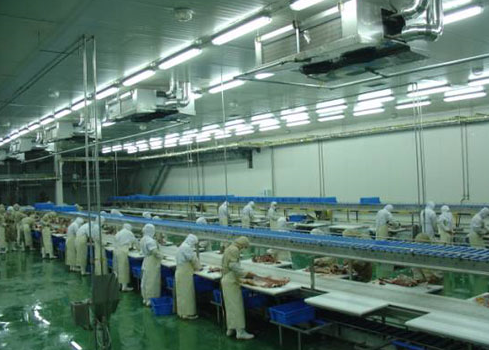Essential Design Standards for Slaughterhouse Cold Rooms
Temperature & Humidity Control Requirements
Keeping temperatures and humidity just right in slaughterhouse cold rooms makes all the difference when it comes to meat safety and quality. Most facilities aim for temps somewhere around 0 to minus 5 degrees Celsius because that range really slows down bacteria growth on those carcasses. Humidity also needs attention - typically kept between 85% and 90%. This balance stops meat from drying out but keeps condensation at bay too. Digital monitoring systems have become pretty standard these days for tracking temperature swings and humidity changes as they happen. And smart operators install alarm systems that kick in when things start drifting outside safe ranges. These alerts let staff fix problems fast before anything gets compromised in storage. After all, nobody wants spoiled product or recalls down the line.
Steel Structures & Material Durability
Steel frameworks in slaughterhouse cold rooms need to last through all sorts of environmental challenges while keeping things running smoothly. That's why most builders go with stainless steel materials these days since they resist rust so well, which means these cold storage areas won't fall apart after just a few years of operation. The right materials also help keep temperatures stable inside those rooms, something absolutely necessary when trying to maintain proper chilling conditions for meat products. Food safe coatings get applied too because cleanliness is non-negotiable in these environments where regular deep cleans happen frequently. When looking at how these materials hold up across different weather patterns and operational stresses, it becomes clear why steel remains such an important part of any serious cold storage setup, especially when dealing with large scale refrigeration systems and industrial freezers that run constantly throughout the year.
Airflow Optimization & Carcass Spacing
Getting the airflow right and positioning carcasses properly makes all the difference when it comes to preserving meat in cold storage areas. When carcasses are laid out strategically, they allow better air movement around them which cuts down on spoilage problems. Installing fans at key points and making sure vents are placed correctly helps distribute cool air evenly across the entire cold room space. This kind of setup works much better than just hoping for good results. Checking airflow patterns regularly is something every facility needs to do if they want their cooling systems to work as intended. Staff members should be trained on proper spacing between carcasses so everyone knows what distance counts as safe from a quality standpoint. Following these guidelines isn't just about meeting regulations either. Meat stays fresher longer when refrigeration units aren't overworked trying to compensate for poor airflow conditions.
Reliable Refrigeration Systems for Meat Preservation
Air-Cooled vs. Commercial Condensing Units
When deciding between air cooled systems and commercial condensing units, meat processors need to look at several key factors including how much energy they consume, how easy they are to install, and what kind of maintenance work they'll require over time. Air cooled models tend to be easier on the wallet upfront since installation is straightforward and running costs stay relatively low. But for bigger facilities handling large volumes of product, commercial condensers often deliver better performance and last longer under heavy use conditions. Facility managers should really dig into the numbers when comparing initial investment versus ongoing expenses because this affects not just day to day operations but also the overall quality of meat storage over months and years. Getting input from refrigeration specialists makes sense here, especially considering differences in plant layout, production capacity, and specific temperature control needs throughout different parts of the processing line. Taking all these variables into account helps select equipment that actually works well within the unique constraints of any given slaughter operation.
Maintaining Sub-Zero Temperature Consistency
Keeping things consistently below freezing is really important when it comes to storing meat properly. Modern tech helps maintain those stable temps, cutting down on the chance of food going bad. Regular checkups and maintenance work go a long way too. They stop breakdowns before they happen and make sure freezers last longer. Don't forget to keep track of temperature records either. Paperwork might seem tedious, but it shows compliance with health regulations and gives some peace of mind during audits. A good idea is having spare generators or secondary cooling units ready just in case something goes wrong. Meat processors know all too well what happens when power cuts hit at night. All these steps together build up reliable cold storage systems that protect both product quality and customer safety in the end.
Sanitation Protocols for Hygienic Cold Storage
Hygiene-Centric Flooring & Surface Materials
Keeping things clean in cold storage areas begins with picking the right floor and surface materials from the start. Non porous surfaces that meet food safety standards make all the difference when it comes to staying clean and avoiding cross contamination issues. Facility managers should check these surfaces regularly too because even small cracks or stains can become big problems down the road. A good rule of thumb is to set up regular inspections and have plans ready for fixing or replacing damaged areas as needed. Don't forget about proper drainage either. Good drainage makes cleaning much easier and stops standing water that breeds bacteria. We've seen cases where poor drainage led to serious contamination problems despite otherwise good cleaning protocols.
Routine Cleaning & Disinfection Procedures

Keeping cold storage areas clean requires good routines for both regular cleaning and disinfection. Facilities should set up cleaning schedules covering different time frames from day to day tasks all the way through monthly deep cleans. This approach makes sure no spot gets overlooked over time. When choosing disinfectants, safety matters just as much as killing germs. Meat products need protection too after all. Staff members must be properly trained on how to do these cleaning jobs right. Some hands-on demonstrations work better than just reading manuals sometimes. Checking sanitation practices regularly also helps catch problems before they become big issues. These audits reveal where improvements are needed and confirm whether hygiene standards stay consistent across operations.
Compliance with Food Safety Regulations
HACCP Integration in Cold Chain Monitoring
Putting HACCP principles into practice for cold chain monitoring really makes a difference when it comes to keeping food safe. The HACCP system works by looking at where things might go wrong during storage and transport of perishables like meat products. When companies figure out those weak spots in their operations, they can put measures in place to stop contamination before it happens. Meat stays safer this way because potential problems get addressed early on. Keeping track of everything through proper documentation matters too. Good records show exactly what was done when, and regular checks help confirm everyone follows the safety rules consistently. Staff need ongoing training about HACCP requirements so they understand why certain steps matter. People who work with refrigeration units daily should know how to spot issues with temperature controls or maintenance needs, since faulty equipment can ruin months of careful planning.
Audit Preparedness & Documentation
Getting ready for audits means having good documentation in place so we can actually evaluate things properly. My team keeps track of all sorts of stuff including temperature logs, when we clean everything, and what maintenance work gets done on those big condensing units. We want to make sure nothing slips through the cracks when it comes to food safety standards. We run internal checks pretty regularly too because catching problems early saves everyone headaches later on when outsiders come looking. Third party auditors also play their part here since they bring fresh eyes to our operations. Their assessments help us stay compliant not just locally but internationally as well. They often point out improvements we hadn't considered before, like better steel structures for cold storage facilities or ways to upgrade how we install cold rooms across different warehouses and logistics centers.
Table of Contents
-
Essential Design Standards for Slaughterhouse Cold Rooms
- Temperature & Humidity Control Requirements
- Steel Structures & Material Durability
- Airflow Optimization & Carcass Spacing
- Reliable Refrigeration Systems for Meat Preservation
- Air-Cooled vs. Commercial Condensing Units
- Maintaining Sub-Zero Temperature Consistency
- Sanitation Protocols for Hygienic Cold Storage
- Hygiene-Centric Flooring & Surface Materials
- Routine Cleaning & Disinfection Procedures
- Compliance with Food Safety Regulations
- HACCP Integration in Cold Chain Monitoring
- Audit Preparedness & Documentation

